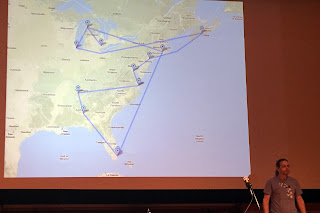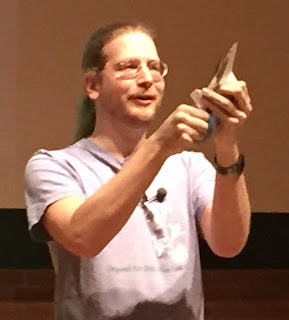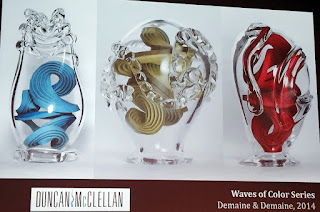Last Monday was real treat to listen MIT Professor Erik Demaine talking how his math and art interests have intertwined. Demaine joined the MIT faculty in 2001 at age 20, reportedly the youngest professor in the history of the Massachusetts Institute of Technology.
Erik was born in Halifax, Nova Scotia, and from the age 7 to 12 he was travelling with his father artist Martin Demaine - homeschooling at that time worked perfectly. They both learned a lot from the communities they lived over those 5 years. At the age 12 Erik enrolled in college and 2 years later he had completed his bachelors degree.Demaine's PhD dissertation was a seminal work in computational origami which later was incorporated into the book which is also in my home library and I had a chance it to be signed by the author.
Erik's work had sparked great interest around the world - just look at the list of his collaborators....


Some skeptics may ask what is the practical use of this fun with origami. Erik has an answer - his latest work has practical applications - it is about so called "thick folding" - usually paper thickness is counted as almost negligible but in reality and with other materials thickness is significant factor.
I remember this work from the exhibit "Measure for Measure" (2011) in Central Booking when it was still in DUMBO (I had my crocheted manifold pieces in the same show.)
Computational algorithms for geometric origami is cool thing to learn - Erik Demaine can teach a lot and also to spark ideas. Videos of his lectures are available from his webpage.
One of the hobbies of father-son team is to come up with various fonts that correspond with their artistic and mathematical interests. As Erik said - they taught each other - father taught Erik to be an artist, Erik taught his father to become a mathematician.
Question from the audience - what are those two last fonts? Erik smiles - they are juggling fonts, I do not have juggling balls with me... But there is Allen Knutson, one time world record holder in passing 12 balls, in audience - and he always has juggling balls with him, he often uses when lecturing mathematics. So Erik has an opportunity to demonstrate how to juggle each letter of the alphabet.
There are old stories about folding paper sheet so that with one cut you can make some figures.
Even famous magician Houdini was interested in this kind of magic.
This lead to Fold and Cut Problem.
Traditional origami is all about folding stright lines. Erik and Martin Demaine's were puzzled - how about folding curves? They discovered the legacy of David Huffman and perfected it in their own way. It is an interesting history of Curved Origami Sculptures.
In origami sky is the limit. These days father-son team with the help of others are interested in folding the glass.
What else can be folded? More and more books are being digitized which makes printed books ...well, often to be discarded. Artists are taking over and trying to recycle them in creative ways. Of course, origami masters Demaines have their own challenge - for example, to fold a dictionary that you read one language in one diraection but the translation is on the other side of the crease.
Thank you for the great talk, Erik!




































No comments:
Post a Comment